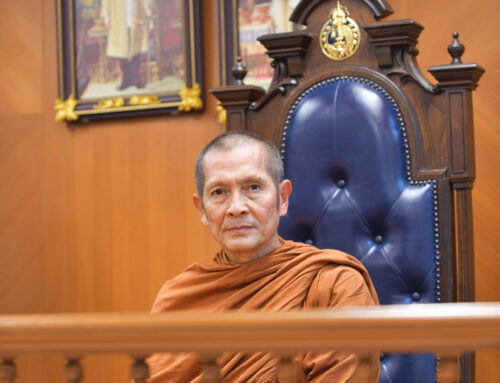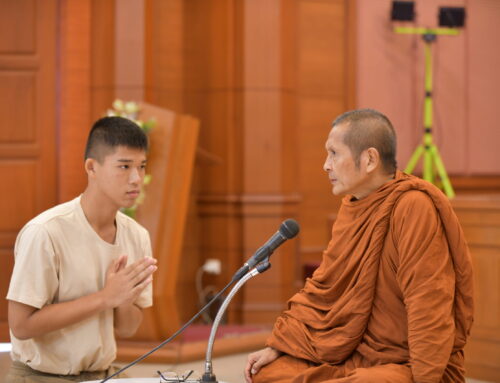
“…ถ้ารู้แล้ว…ยึด… คือยึดมั่นถือมั่นสำคัญมั่นหมาย ไม่ว่ารูปว่านาม ไม่ว่าดีหรือชั่วบุญหรือบาป ผลก็คือ “ปฏิจจสมุปบาท” … อวิชชา ปัจจยาสังขารา ฯลฯ (ปฏิจจสมุปบาท) นี่แหละ คือกลไกที่จะนำไปสู่ยีน DNA ..เป็น “จีโนม” ภาคพุทธศาสตร์ในทรรศนะของเรา) ซึ่งก็คือความเป็นจริงที่มีอยู่แล้ว ที่พระพุทธเจ้า ทรงค้นพบเรียกว่า “อิทัปปัจจยตา” (เพราะมีสิ่งนี้ๆ เป็นเหตุเป็นปัจจัยสิ่งนี้ๆจึงมี) มันจึงเป็นการเกิดขึ้นที่พอดี…พอดีกับเหตุและผลนั้นๆไม่ว่าเป็นสิ่งที่มีชีวิตหรือวัตถุสิ่งของ แต่ในเมื่อมีการเกิดขึ้นก็จะต้องมีการดับไปเป็นธรรมดา…ธรรมดาที่เรียกว่า ไตรลักษณ์ อันมี อนิจจัง ทุกขัง อนัตตา ซึ่งมีสภาพ เกิดขึ้น ทรงอยู่และจะต้องดับไปหาความจีรังยั่งยืนอะไรไม่ได้ ไม่ว่ารูปหรือนามไม่ว่าเป็นสิ่งที่มองเห็นหรือมองไม่เห็นทั้งที่มีวิญญาณครองหรือไม่มีวิญญาณครอง ทั้งเรื่องดีหรือชั่ว บุญหรือบาป สุขหรือทุกข์ ความแปรปรวนเปลี่ยนแปลงอยู่ตลอดเวลาตามเหตุตามปัจจัย ไม่ว่าเรื่องของคนของสัตว์หรือสิ่งของ สภาวะ เหล่านี้แหละเรียกว่า …ธรรมชาติ….
…แต่ถ้ารู้แล้ว..วาง…(รู้ด้วยเหตุด้วยผล รู้ทั้งคุณทั้งโทษ รู้จากสติปัญญาที่มี สัมมาสมาธิ เป็นฐานรองรับเป็นฐานสนับสนุนเป็นปัญญาที่เห็นจริงตามเป็นจริง ทั้งเรื่อง รูป อันหมายถึง รูปลักษณ์สกนธ์กายที่มองเห็นกันอยู่นี่แหละ แล้วก็เรื่องของ นาม อันได้แก่ เวทนา สัญญา สังขาร วิญญาณทั้งหมดทั้งสิ้นเหล่านี้ ล้วนเห็นเป็น อนิจจัง ทุกขัง อนัตตา หมดไม่ว่าเขาว่าเรา..ก็เลยไม่มีเขาไม่มีเรา ไม่มีของเขาไม่มีของเรา จึงไม่มีเหตุไม่มีปัจจัยให้หลงปรุงหลงแต่ง ให้หลงยึดหลงถือ…ก็เลยไม่มีภพ …จึงไม่มี..ชาติ…)…รู้แล้ว..วาง…รู้แล้ว..วาง…มันจึงมีแต่ความพอดีล้วน ๆ…เหลือแต่ความพอดีล้วนๆนั่นล่ะ…ธรรมะ…“ผู้ใดเห็น ธรรม ผู้นั้นเห็นเรา ตถาคต แล”…นี่!..เรื่องมันเป็นอย่างนี้ มันต้องรู้อย่างนี้ มันต้องเห็นอย่างนี้…ศาสนาพุทธน่ะ…เอวัง..”
19 พ.ค. 2549
Dhamma….the Chart (The Common)
When you know something and firmly cling with it. That is the attachment. No matter they are nama (mind) or rupa (matter), merit or demerit, the result is the “paticcasamupāda” (the Dependent Origination), the ignorance, the kamma formation, will arise. “Paticcasamupāda” (the Dependent Origination), is an organ of producing of gene of DNA, a version of “Genome” in Buddhist perspective. In reality, it is the Truth that the Buddha discovered; called “idappaccayyatā, specific conditionality” (because there is this thing, then it causes that thing arises.) It is a ripening phenomenon, which fits to the cause and effect including living beings or material things. Yet, when there is arising, there is decay. It is called the trilakhana, three marks of existences that are, aniccam (impermanence), dukkham (suffering), and anattā (selfless), which are happening, sustaining, and finally declining, unable to find permanency. No matter what they are, all are impermanent including nama and rupa, visible or invisible things, possessed with soul or soulless, good or bad, wholesome or unwholesome, happiness or sorrow. Everything is subject to change according to its cause and effect. There is no exception for what it is, concerning animals, human beings, these are conditioning things, which is called the nature.
But, if we know, then release it (to know the cause and effect, advantage and disadvantage though wisdom of the Right Concentration (Sammāsamadhi) as the fundamental factor and supporter. It is the wisdom that see things as they really are. Both rupa, which means the visible body, and nama the invisible things, namely vedana(feeling), sañña(consciousness), samkhara (formation),viññaṇa (perception), all are seen as aniccam, dukkham, anatta. No matter others or ourselves, there is no “you” and “me”, no yours and mine. Therefore, there is no cause, there is no condition to exist, to attach, then there is no bhāva (becoming), jāti (birth). Once you know, then release therefore, there are appropriateness or rightfulness. As we have seen, this systematically procedural thought is so called Dharma. “ Anybody can see Dharm, those will also see me Datakot (Lord Buddha)” The event is like this, it must know like this and it has to see this so in accordance with Buddhism.
May 19, 2006







